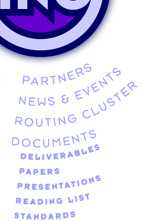  |
| 216.73.216.61 |  |
|||
  |
 |
|||||

Latest News
RiNG Events
|
Home
Summary: The goal of RiNG is to support the coordination, study and analysis of routing protocols on the Internet, to identify and analyze the challenges ahead, considering the current and future expected Internet growth. This will lead to proposals for novel approaches towards the evolution of routing. The project has set up an expert group, which will be open to the participation of other experts by collaborative means, leading to a broader community "think tank" on the topic. This "Routing Cluster" will include not only experts from other relevant IST projects, but also from related international activities. The project will analyze and document the state of the art in standardization and policy, survey the users and service providers, and propose further alternative research and innovation strategies to address the identified challenges. Through its activities the project will seek to foster the European participation in the related pre-standardization, standardization and policy making processes, to monitor the developments and to disseminate the results. The research and innovation strategies proposed in the project will most probably require further standardization and elaboration of the policy. The project will therefore look for a community consensus on implementation of the project results by means external to the project. Objectives: 1. To coordinate a community "Think tank" on routing aspects (Routing Cluster), providing operational support for the organization of open working meetings and other collaboration tools, such as an e-mail exploder and web site. 2. To survey both ISP and user (site) requirements for routing in the next generation of networks. 3. To analyze the related state of the art in standardization and policy versus the user/ISP perceived requirements. 4. To develop research and innovation strategies for inter-domain routing evolution. 5. To disseminate the project and related results, including the relevant standardization and policy activities. Innovation: The results of this project are expected to produce an impact on the standardization process, by means of encouraging the members and partners of the Routing Cluster to start this type of activities or to increase existing ones, with the overall result of increasing European contributions to standardization, and not just from the project participants. To ensure the benefits of new routing architectures, new international standards could be required. Therefore there is a need to actively cooperate with the respective standardization bodies, in order to support the Routing Cluster membership. Technology Approach: The project will identify a number of issues regarding the current routing protocols and infrastructure and their ability to support the new services in a scalable manner: 1. Resilience and scalability (even millions of prefixes) and quick convergence after failures. The convergence time of BGP in case of failures is often measured in tens of seconds; this is not acceptable for mission critical services or emergency situations, for instance when VoIP is widely deployed and PSTN services may become no longer available in homes and businesses, while they may be connected to multiple services providers and/or different access networks (multihoming situations). 2. Desire of end-sites to be provider-independent (PI) by having their own prefixes, especially with IPv6 (which currently has no PI address space). This may be the case either for technical (load-balancing, resilience, etc.) or administrative reasons (corporate policy, security, etc.). 3. Inter-domain traffic engineering (or even QoS). BGP was designed with a best effort Internet in mind. It only advertises a single path per prefix and does not take into account QoS metrics in the selection of the inter-domain. The traffic engineering is also difficult. 4. Security of the routing infrastructure (e.g., protection against prefix hijacking), prevention of configuration errors and mechanisms to better deal with denial of service attacks (DoS). 5. Mobile networks. Utilization of IP in airplanes, cars, trains, ships and other transport means not only for Internet connectivity, but also to provide a communication among vehicles (e.g., Car to Car communications for eSafety). 6. On-demand or dynamic layer 1 or 2 media (e.g., on-demand WDM circuits). Test Bed: The open "Routing Cluster" of RiNG will support the work of different research groups, standardization organisms and bodies in charge of policy-making, with the aim to improve the networks of tomorrow. The participation of the RiNG expert partners in several research fora and projects carrying out activities related to the RiNG's aims brings added value to this project. On the other hand, as the project is not carrying out research directly but is basing its activities on the outcomes of previous or current projects and activities related to routing in next generation networks, protocols and technologies (such as IPv6, but not exclusively), these efforts will be coordinated with a wider community support to succeed from the standardization perspective. |

DISCLAIMER: "RiNG is a part-funded EC (IST-2005-035167) project. The information/views generated by the project may not completely align with those of the individual participating companies or The European Community. Although the project's information/views are considered accurate no responsibility will be accepted for their subsequent use."
|
||||
